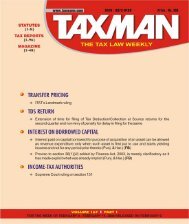CPT V24P7-Art1 (Content).pmd - Taxmann
CPT V24P7-Art1 (Content).pmd - Taxmann
CPT V24P7-Art1 (Content).pmd - Taxmann
Create successful ePaper yourself
Turn your PDF publications into a flip-book with our unique Google optimized e-Paper software.
Direct Tax Laws<br />
ANALYSIS OF THE DECISION OF THE<br />
MADRAS HIGH COURT IN DR. (SMT.)<br />
P.K. VASANTHI RANGARAJAN’S CASE<br />
(SUPRA)<br />
2. The assessee was a joint owner, along with<br />
her husband of an immovable property A. The<br />
property consisted of a clinic in the ground<br />
floor and a residential portion on the first<br />
floor. The assessment year concerned was 2000-<br />
01. The assessee had been declaring 50% of<br />
the share in the property as owned by her in<br />
the wealth-tax assessment since 1989-90. The<br />
assessee had entered into a joint development<br />
agreement with a builder/promoter for<br />
construction of eight flats/apartments in the<br />
property B owned by her during the financial<br />
year 1998-99 and parted with possession of<br />
the property during the previous year, pertaining<br />
to the assessment year 2000-01. As per the<br />
terms of the agreement the builder/promoter<br />
would construct all the eight flats at its cost<br />
and would allot four flats to the assessee by<br />
retaining the other four flats for its business<br />
purposes. Though initially the assessee argued<br />
that the transfer of property took place during<br />
the previous year pertaining to the assessment<br />
year 2001-02 on account of handing over of<br />
(completed) flats only in June 2000, the issue<br />
was confirmed by the Tribunal that the correct<br />
assessment year in which transfer took place<br />
by way of handing over of property to the<br />
builder/promoter was 2000-01 and not 2001-<br />
02 as contended by the assessee. The dispute<br />
with regard to the year in which assessment<br />
had to be made did not travel further, as the<br />
decision rendered by the Tribunal attained<br />
finality on this issue.<br />
The assessee claimed benefit of exemption under<br />
section 54F of the Income-tax Act, as she had<br />
invested in purchase of a residential property<br />
within the stipulated limit as set out in section<br />
54F of the Act. The Assessing Officer rejected<br />
the contention of the assessee as the then proviso<br />
to section 54F disentitled the assessee from<br />
claiming the benefit for investing the capital<br />
gains in yet another house property. It is to<br />
650<br />
August 1 to 15, 2012 u TAXMANN’S CORPORATE PROFESSIONALS TODAY u Vol. 24 u 30<br />
be noted that the assessee was a joint-owner<br />
of a residential property at that time. The<br />
disallowance made by the Assessing Officer<br />
stood confirmed till the Tribunal’s stage. The<br />
assessee filed an appeal in the High Court.<br />
The High Court agreed with the contention<br />
raised on behalf of the assessee that “when the<br />
individual assessee owns a residential house<br />
along with somebody else under a joint<br />
ownership or as a co-owner therein, the<br />
ownership in a status other than that of<br />
individual/HUF would not result in denial of<br />
exemption”.<br />
The High Court after assimilating facts made<br />
the following observations at para 13 of its<br />
order-<br />
“The facts thus reveal that as joint owners<br />
of the property, the assessee and her<br />
husband had shown 50% share with<br />
reference to the clinic and the residential<br />
portion in their respective returns. Thus,<br />
it is clear that as on the date of the<br />
transfer, the assessee did not own a<br />
residential house in her name only, the<br />
income from which was chargeable under<br />
the head “income from house property”,<br />
to bring into operation, the proviso to<br />
section 54F. The rejection of the claim for<br />
exemption would arise if only the property<br />
stands in the name of the assessee, namely,<br />
individual or HUF. Given the fact that<br />
the assessee had not owned the property<br />
in her name only to the exclusion of anybody<br />
else including the husband, but in joint<br />
name with her husband, we agree with<br />
the submission of the learned senior counsel<br />
appearing for the assessee herein that<br />
unless and until there are materials to<br />
show that the assessee is the exclusive<br />
owner of the residential property, the<br />
harshness of the proviso cannot be applied<br />
to the facts herein. Apart from that, 50%<br />
ownership is with reference to the clinic<br />
situated in the ground floor. As such, the<br />
entire property is not an exclusive<br />
residential property. Hence, we are inclined











![“FORM NO. 3CEB [See rule 10E] Report from an ... - Taxmann](https://img.yumpu.com/45480232/1/190x245/form-no-3ceb-see-rule-10e-report-from-an-taxmann.jpg?quality=85)





